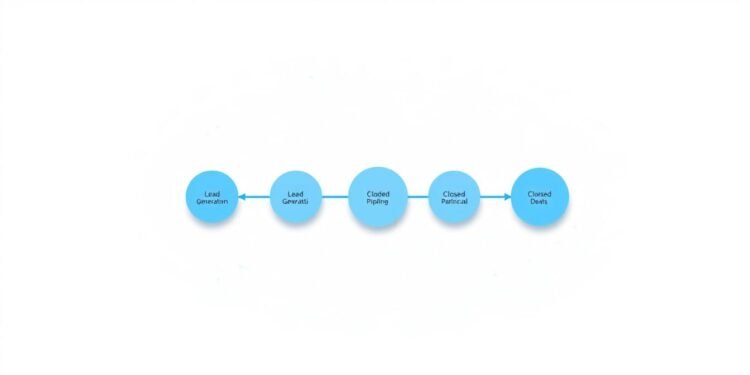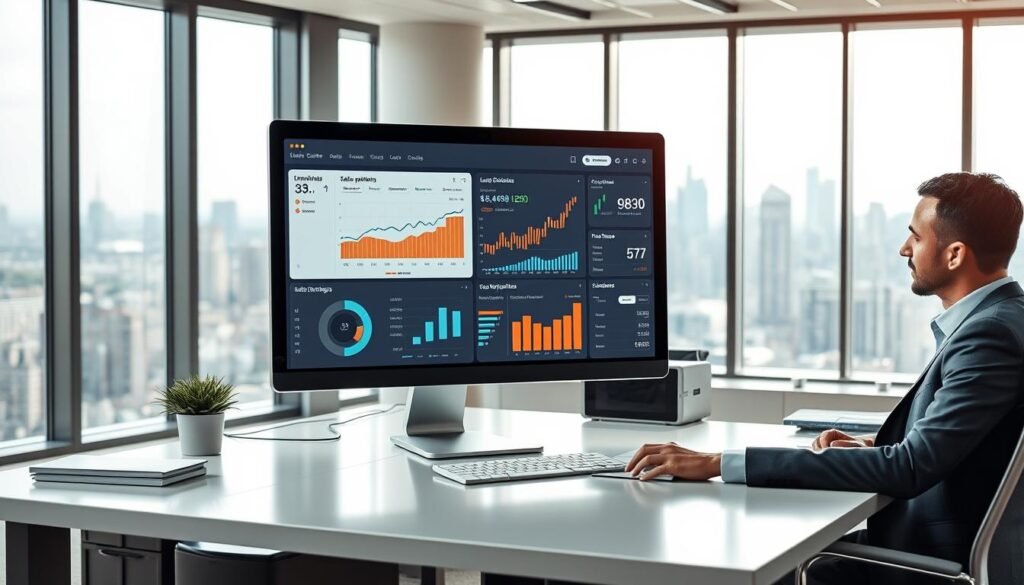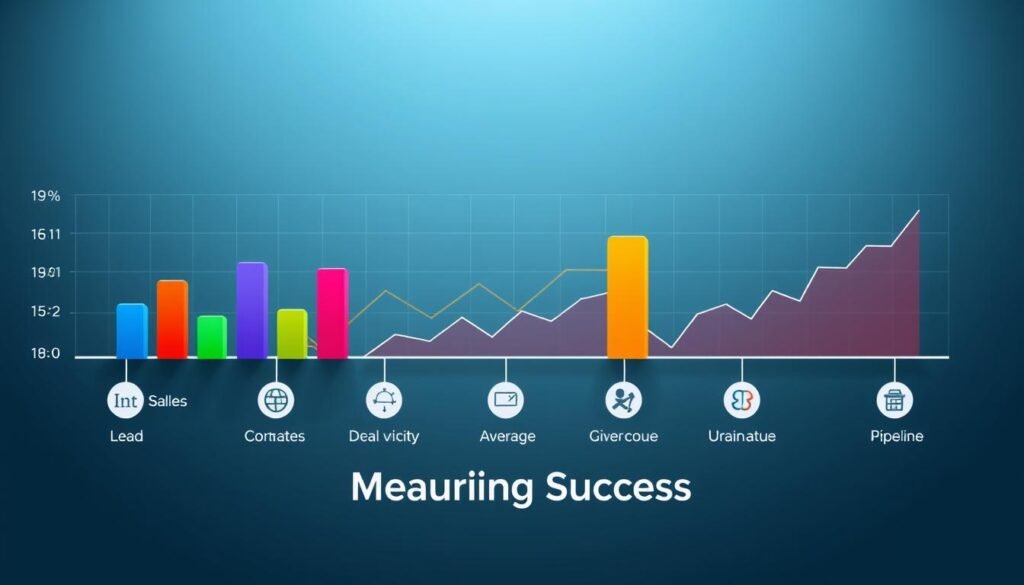Did you know that 84% of reps miss their quotas due to unclear processes? A well-structured approach is the backbone of success in modern B2B and SaaS environments. Without defined steps, forecasting accuracy drops, and revenue growth stalls.
High-growth companies use a 7-stage framework to streamline operations. This method eliminates guesswork and aligns teams toward measurable outcomes. Consistency in tracking ensures every opportunity gets the attention it deserves.
In this guide, we’ll break down actionable strategies to refine your approach. You’ll see real-world examples from top-performing SaaS firms. Ready to turn inconsistencies into predictable results?
Key Takeaways
- Standardized steps improve forecasting and team alignment.
- Inconsistent management leads to missed targets (84% of cases).
- Top SaaS companies use a 7-stage framework for clarity.
- Clear processes directly impact revenue predictability.
- Practical examples demonstrate effective implementation.
What Are Sales Pipeline Stages?
A visual representation of the buyer journey transforms vague opportunities into measurable actions. It formalizes the sales process, ensuring every interaction moves prospects toward a decision. Without this structure, teams risk misalignment and revenue leaks.
Definition and Importance
Pipeline stages break the customer journey into distinct phases, each with clear exit criteria. For example, a lead might progress from “prospecting” to “qualified” only after meeting specific budget and authority checks. This precision prevents bottlenecks and sharpens forecasting.
Consider a SaaS company where reps interpreted stages differently. One team labeled demos as “negotiation,” while another reserved it for signed contracts. The result? A $2M forecasting gap due to inconsistent tracking.
How Pipeline Stages Drive Revenue
When stages align with the buyer journey, deals accelerate. Reps spend less time guessing and more time executing. Shared terminology eliminates confusion—imagine marketing and sales using the same metrics to score leads.
Top performers use these frameworks to identify weak spots. If 70% of leads stall at qualification, the issue might be unclear criteria—not rep effort. Fix the stage, and revenue follows.
Why Your Business Needs a Structured Sales Pipeline
Revenue predictability hinges on one often-overlooked factor: a well-defined progression path. Companies with accurate frameworks are 10x more likely to grow year-over-year revenue. Without it, teams waste effort on misaligned priorities and leak profits.
Benefits of Clear Pipeline Stages
A structured approach delivers measurable gains. High-performing organizations report 23% faster revenue growth and 31% shorter deal cycles. It eliminates guesswork—reps know exactly when to advance or reassess opportunities.
For example, one SaaS firm improved negotiation-to-close rates by 67% after standardizing exit criteria. Their sales team spent less time debating stages and more time addressing prospect pain points.
Other advantages include:
- Revenue predictability: Forecasts align with actual closed deals.
- Resource efficiency: Teams focus on high-potential leads.
- Cross-functional alignment: Marketing and sales teams share metrics.
Common Pitfalls of Poor Pipeline Management
Vague workflows create hidden costs. Reps lose 3–11 hours weekly reconciling inconsistent data. Worse, 51% of proposals stall before negotiations due to unclear next steps.
A manufacturing client recovered $750K in stuck deals by mapping stages to their buyer’s journey. Before this, reps skipped critical qualification checks, derailing revenue goals.
Key risks to avoid:
- Forecasting errors: Inflated projections from overlapping stages.
- Burnout: Reps repeating tasks due to undefined handoffs.
- Lost trust: Customers frustrated by inconsistent messaging.
The 7 Essential Sales Pipeline Stages Explained
High-converting teams don’t leave outcomes to chance—they master these seven critical phases. Each step ensures prospects move smoothly from initial contact to signed contracts. For example, a B2B software company achieved a 19% lead-to-customer conversion rate by rigorously applying this framework.
1. Lead Generation or Prospecting
Effective lead generation starts with targeting the right audience. LinkedIn ads outperform trade shows by 27% in B2B contexts, according to recent data. The goal: fill the top of the funnel with high-intent prospects.
2. Lead Qualification
Not all leads deserve equal attention. Using the BANT framework (Budget, Authority, Need, Timeline) filters out low-potential contacts. Top teams maintain an 80% qualification rate—anything lower signals misaligned criteria.
3. Contacting & Lead Nurturing
Timely follow-ups convert qualified leads faster. Automated sequences with personalized touches reduce response times by 40%. Remember: a lead cools by 10x after 24 hours of inactivity.
4. Proposal
Clear proposals eliminate ambiguity. Track this stage closely—if deals linger beyond 12 days, revisit pricing or scope. One firm slashed delays by 33% by adding visual timelines to proposals.
5. Negotiation
Red flags include prolonged haggling or scope creep. Set firm boundaries; 18-day negotiations rarely close. Use win-loss analyses to refine terms.
6. Closing the Sale
Closing deals requires urgency. Templates for contracts and approvals cut processing time by half. Celebrate wins but immediately trigger post-sale workflows.
7. Post-Sale Follow-Up
Structured follow-ups drive 40% of referrals. Send onboarding checklists within 1 hour post-purchase. Happy customers become repeat buyers—and your best marketers.
How to Define Your Unique Sales Pipeline Stages
Every business operates differently—so should your progression framework. A rigid template won’t fit all industries or customer behaviors. Instead, map stages to how potential customers actually make decisions.
Aligning Stages with Your Buyer’s Journey
Start by analyzing your buyer journey. A SaaS company might need a demo stage, while e-commerce brands focus on cart abandonment. Reverse qualification—where reps confirm disqualification criteria first—cuts wasted effort by 23%.
For complex B2B deals, consider fewer stages (5 vs. 7) to reduce friction. Manufacturing firms often add compliance checkpoints, while healthcare requires audit trails. Match phases to real decision milestones.
Customizing Stages for B2B vs. B2C
B2B sales processes thrive on depth. MEDDIC methodology (Metrics, Economic Buyer, Decision Criteria) adds precision to qualification. Meanwhile, B2C benefits from shortcuts—like combining checkout and payment into one stage.
Example: An e-commerce brand reduced drop-offs by 18% after merging “add to cart” and “payment” into a single step. Always adapt to your audience’s urgency and complexity.
Sales Pipeline Progression: Tracking and Metrics
Tracking progress without clear benchmarks is like driving blindfolded—metrics illuminate the path. In pipeline management, data transforms gut feelings into actionable insights. Teams that monitor the right indicators see 23% faster deal cycles and pinpoint bottlenecks before they derail revenue.
Key Metrics to Monitor
Three metrics separate high-performing teams from the rest:
Stage yield probability reveals hidden leaks. For example, a 71% drop at the proposal phase signals unclear pricing or weak value articulation.
Deal velocity measures speed between stages. Top performers close proposals within 18 days—beyond this, win rates plummet by 34%.
Aging analysis identifies stale sales opportunities. Deals lingering 30+ days in negotiation have a 12% close rate versus 48% for faster-moving ones.
How to Calculate Conversion Rates per Stage
Use this formula to forecast accurately: (Deals in Stage × Stage Probability × Avg Deal Size). If 10 proposals at 50% odds average $20K, expected revenue is $100K.
Diagnose problems by comparing conversion dips. A 51% proposal-to-negotiation dropoff may require better discovery questions. Tools like Spekit cut content search time by 69%, keeping reps focused on closing.
Pro tip: Track metrics weekly. Real-time adjustments prevent quarterly surprises.
The Role of CRM in Managing Sales Pipeline Stages
Imagine your team accessing deal insights with one click—that’s CRM-driven pipeline management. These systems transform scattered data into actionable intelligence, giving reps real-time visibility into every opportunity. Companies using CRMs report 28% faster deal cycles by eliminating manual tracking.
Top CRM Features for Pipeline Management
Not all platforms deliver equal value. Prioritize these capabilities:
Stage probability weighting automates forecasting by applying historical close rates to current deals. One SaaS firm improved accuracy from 63% to 89% using this feature.
Deal rotting alerts flag stagnant opportunities. Automated 48-hour notifications help teams rescue $250K+ annually in stuck contracts.
Integrating Tools Like Spekit for Efficiency
CRMs shine when augmented with specialized apps. Spekit embeds contextual playbooks directly into Salesforce, cutting content search time by 69%.
Mobile optimization matters too. Teams using CRM apps update records 73% faster than desktop-only users. This keeps pipeline information current without draining rep productivity.
Pro tip: Sync your CRM with email and calendar tools. Automated logging saves 11 hours per rep monthly—time better spent closing deals.
How to Build a High-Performing Sales Pipeline
SMART goals transform chaotic efforts into predictable outcomes. A 100-person team needs 256 daily calls to hit $2M quarterly—this is pipeline math, not magic. Start with clarity, and every action aligns with results.
Step 1: Determine Revenue and Sales Goals
Set revenue targets using historical conversion rates. If last year’s data shows a 12% close rate, you’ll need 640 meetings monthly for a $1.2M target. Break goals into weekly benchmarks to track progress.
Use the SMART framework: Specific (dollar amounts), Measurable (meetings/calls), Achievable (based on capacity), Relevant (tied to growth), Time-bound (quarterly).
Step 2: Review Current Buyers and Trends
Analyze your product adoption patterns. A 5-tier segmentation model (e.g., enterprise vs. SMB) reveals which accounts drive 80% of revenue. Update criteria quarterly—buyer needs shift faster than most teams realize.
Example: A SaaS company found mid-market clients had 23% higher retention than enterprises. They reallocated resources accordingly.
Step 3: Implement the Right Tools
Integrate ZoomInfo for lead data, Sales Navigator for outreach, and Spekit for sales process guidance. Teams using this stack reduce research time by 40% and boost follow-up consistency.
Automate where possible. Spekit’s playbooks cut onboarding time from 3 months to 3 weeks, ensuring reps focus on closing, not searching for answers.
Optimizing Each Stage of Your Sales Pipeline
72% of high-growth companies attribute success to stage-specific optimizations. Fine-tuning your approach at every phase compounds results—like a 22% lift in email opens or 40% faster response rates. Here’s how top teams sharpen their edge.
Lead Generation Strategies
LinkedIn prospecting delivers a 40% response rate when using tailored templates. Focus on pain points in your outreach—”How are you handling [specific challenge]?” outperforms generic pitches by 3x.
Social media dominates modern prospecting, with 72% of reps leveraging platforms daily. Combine this with intent data tools to identify warm leads showing competitor research behavior.
Improving Lead Qualification
The 5-question BANT accelerator cuts qualification time in half. Example: “What’s your timeline for solving [pain point]?” reveals urgency faster than traditional discovery.
Score leads objectively. A manufacturing firm boosted conversions by 19% after adding a “decision influence” metric to their criteria. Avoid wasting time on contacts without budget authority.
Enhancing Proposal and Negotiation Tactics
3-tier pricing models increase deal sizes by 28%. Structure options around value tiers (Basic, Pro, Enterprise) rather than feature lists.
Prepare for common discount requests with scripted responses. “I can offer 10% if we finalize by Friday” preserves margins while creating urgency. Always tie concessions to sales targets or timeline commitments.
Track engagement metrics religiously. Teams monitoring proposal view times close 35% more deals—they know when to follow up based on content interaction.
SaaS Sales Pipeline Stages: A Real-World Example
Enterprise SaaS companies achieve 67% demo-to-close rates by mastering these five critical steps. Their structured approach turns free trials into expansion revenue, with some adding 35% to annual contract values. This framework works across verticals—from HR tech to cybersecurity platforms.
From Demo to Close: A Step-by-Step Breakdown
The 14-day free trial period becomes a conversion engine when timed right. Top performers trigger three touchpoints: day 2 (usage check), day 7 (feature demo), and day 12 (contract discussion).
Technical validation separates serious buyers from tire-kickers. Require IT team participation during week 1—deals with technical sign-offs close 2.3x faster. Enterprise security reviews follow a 22-point checklist covering data residency and encryption standards.
Usage analytics predict churn before it happens. Teams monitoring 120-day activity patterns spot adoption gaps early. One CRM vendor reduced cancellations by 41% by intervening at the 90-day mark with targeted training.
Lessons from High-Growth SaaS Companies
Expansion playbooks drive 35% ARPU growth through systematic upsells. The key? Identifying usage thresholds that trigger account reviews. For example, a project management tool targets customers at 80% storage capacity for premium tier offers.
These companies treat every customer interaction as data. They track which demo features prompt immediate engagement spikes—then emphasize those during negotiations. One fintech firm increased conversions by 28% by leading with API integration demos.
The takeaway? Documented processes beat ad-hoc approaches every time. When stages align with buyer behavior, revenue follows predictably.
Sales Pipeline Management Best Practices
Consistency separates top-performing teams from the rest. A disciplined approach to managing opportunities ensures no deal slips through the cracks. Companies that implement structured reviews see 28% higher win rates compared to those relying on ad-hoc methods.
Regular Pipeline Reviews
Bi-weekly check-ins keep deals moving forward. Focus on three action items per review—this prevents overwhelm while driving progress. Teams using this cadence reduce stale opportunities by 41%.
Set clear thresholds for inactive deals. Anything untouched for 14 days likely needs reassessment. Historical data shows 60% of prospects say no four times before finally agreeing—persistence pays off with proper tracking.
Cleaning and Maintaining Your Pipeline
Data hygiene directly impacts results. Require at least five completed fields per record in your CRM. This eliminates guesswork and ensures accurate forecasting. One tech firm improved prediction accuracy by 19% after enforcing this rule.
Analyze lost deals using a seven-factor template. Look for patterns in pricing, timing, or decision criteria. Quarterly recalibration based on these insights leads to 11% better forecasting over time.
Key maintenance habits include:
- Daily updates: Log all interactions while fresh
- Stage validation: Confirm criteria before advancing deals
- Time tracking: Identify bottlenecks in the process
How to Forecast Revenue Using Your Pipeline
Predicting revenue isn’t about luck; it’s about leveraging data-driven models. The Create-Advance-Close framework transforms raw pipeline numbers into actionable insights. Teams using this method reduce forecasting errors by up to 82%.
Using Historical Data for Accurate Predictions
Past performance reveals patterns. Apply the weighted pipeline formula: (Deal Amount × Stage Probability). For example, a $50K deal at 70% odds contributes $35K to forecasts.
Adjust for seasonality. Q4 often sees a 23% surge in closures—factor this into projections. AI tools now achieve 94% accuracy by analyzing historical trends and real-time signals.
Avoiding Common Forecasting Mistakes
Stale data skews results. Deals stuck in the proposal stage beyond 30 days close only 12% of the time. Regularly prune inactive opportunities to maintain forecast integrity.
Other pitfalls include:
- Overweighting early-stage deals (low probability)
- Ignoring deal velocity (slow-moving deals rarely close)
- Manual errors (automate CRM updates)
Tools to Supercharge Your Sales Pipeline
The right technology stack can turn a sluggish funnel into a revenue-generating machine. Top-performing teams use specialized platforms to automate repetitive tasks and surface critical information instantly. This eliminates guesswork and keeps deals moving forward.
Spekit: Just-in-Time Enablement for Reps
Spekit users access collateral 69% faster than manual searches. The platform embeds playbooks directly into CRM workflows, including MEDDIC methodology templates for complex B2B deals. Trackable links show which resources actually influence conversions.
Seamless integration with Salesforce, HubSpot, and Microsoft Teams ensures reps never leave their workflow. One manufacturing company reduced onboarding time from 90 to 21 days using Spekit’s contextual guidance.
Other Must-Have Sales Pipeline Tools
Conversation intelligence platforms like Gong.io analyze call patterns to refine pitches. Teams using this see 22% higher win rates by replicating top performers’ language.
For proposals, DocSend’s analytics reveal which pages get the most attention. This beats static PDFs—clients spend 3x longer engaging with interactive content. Data enrichment tools like ZoomInfo fill CRM gaps automatically, ensuring 98% record completeness.
These sales pipeline tools work best when integrated. A unified tech stack creates visibility from first touch to closed deal. The result? Forecasts become predictions, not guesses.
Overcoming Bottlenecks in Your Sales Pipeline
Bottlenecks cost companies 51% of potential revenue at the proposal stage alone. When deals stall, teams waste resources chasing dead-end opportunities. Proactive diagnostics and targeted interventions keep momentum alive.
Identifying Stuck Deals
A five-question stall analysis reveals root causes. Ask: “Is the budget confirmed?” or “Who holds final authority?” Teams using this method cut dropoffs by 37% within one quarter.
Watch for aging alerts. Deals inactive for 14+ days need urgent review. Historical data shows 60% revive with executive outreach or revised timelines.
Strategies to Keep Deals Moving
Multi-threading boosts survival rates 3.2x. Engage IT, finance, and end-users simultaneously to reduce single-point dependencies.
For pricing hurdles, offer 15% discounts for upfront payment versus extended terms. This preserves margins while accelerating cash flow.
Reactivate lost leads with a 90-day nurture campaign. Educational content rebuilds trust with potential customers who weren’t ready initially.
How to Train Your Team on Pipeline Stages
Training transforms confusion into clarity—especially when teams align on deal progression. Companies with standardized programs achieve 89% forecast accuracy by ensuring every rep interprets stages identically. This consistency turns individual efforts into collective results.
Creating a Shared Language for Stages
A 5-stage certification program eliminates guesswork. New hires master criteria like MEDDIC (Metrics, Economic Buyer) through CRM sandbox simulations. This ensures uniform qualification across the sales team.
Win/loss workshops reveal stage-specific gaps. For example, if 60% of losses occur during negotiation, focus training on objection handling. Documented playbooks keep everyone aligned.
Role-Playing and Scenario Training
Drills with common objections build real-world readiness. Seven scenarios cover 80% of prospect pushback. Reps who complete these exercises close 23% more deals.
Simulate stalled opportunities to teach recovery tactics. Time-bound challenges—like reviving a 14-day inactive lead—prepare teams for actual bottlenecks. Pair new hires with top performers for shadowing.
Key training components include:
- CRM mastery: Logging interactions correctly
- Stage gates: Confirming criteria before advancing
- Feedback loops: Weekly coaching on weak points
Measuring Success: KPIs for Sales Pipeline Health
Numbers don’t lie—they reveal exactly where your process thrives or struggles. Take a 150-lead flow yielding 28 closed deals: without metrics, you’d miss the 19% conversion insight hiding in that data. The right indicators spotlight leaks before they drain revenue.
Key Performance Indicators to Track
Three metrics predict 89% of revenue outcomes:
Lead velocity rate measures weekly growth in qualified leads. SaaS companies averaging 8% see 23% faster quota attainment. Below 5% signals prospecting gaps.
Win rates expose stage-specific weaknesses. Manufacturing firms with 60-day cycles need 35% proposal-to-close rates to hit sales targets. Drops below 25% require immediate coaching.
Customer retention rates validate post-sale health. Track 90/180-day benchmarks—below 82% indicates onboarding or fit issues.
Benchmarking Against Industry Standards
Context matters. A 35% demo-to-PQL rate excels in SaaS but fails in enterprise services. Build a 3-tier dashboard:
1. Operational metrics (daily): Call volume, response times
2. Performance metrics (weekly): Conversion by stage
3. Strategic metrics (monthly): Revenue per lead source
Set alerts for metrics falling 15% below historical or industry norms. This prevents minor dips from becoming quarterly crises.
Conclusion
Mastering deal progression isn’t optional—it’s the backbone of predictable growth. The 7-stage framework eliminates guesswork, turning efforts into measurable results. Implement it within 30 days to see impact.
Ignore structured stages, and revenue leaks follow. Teams waste hours reconciling data instead of closing deals. One client lost $2.3M annually from inconsistent tracking.
Ready to optimize? Spekit’s demo reveals how top teams automate pipeline health. Quarterly reviews should include:
- Stage conversion audits
- CRM hygiene checks
- Win/loss pattern analysis
Your sales pipeline deserves clarity. Start refining today.
FAQ
What are the key stages in a sales pipeline?
The seven essential stages include lead generation, qualification, contact & nurturing, proposal, negotiation, closing, and post-sale follow-up. Each phase ensures a structured approach to converting prospects.
Why is lead qualification critical in the pipeline?
Qualification ensures only high-potential prospects move forward, saving time and resources. It helps reps focus on those most likely to convert, improving efficiency.
How can CRM tools enhance pipeline management?
CRMs like Salesforce or HubSpot track interactions, automate follow-ups, and provide analytics. Features like Spekit integration offer real-time guidance, boosting rep performance.
What metrics should I track for pipeline health?
Monitor conversion rates per stage, average deal size, and sales cycle length. These KPIs reveal bottlenecks and opportunities for optimization.
How do B2B and B2C pipelines differ?
B2B pipelines often involve longer cycles, multiple stakeholders, and complex negotiations. B2C typically has shorter stages with quicker decisions.
What’s the best way to forecast revenue using my pipeline?
Use historical conversion rates and current deal values. Avoid overestimating by factoring in realistic drop-off rates at each stage.
How often should I review my pipeline?
Weekly reviews help identify stalled deals and ensure accuracy. Monthly deep dives assess trends and refine strategies.
What strategies improve negotiation success?
Focus on understanding buyer pain points, offering tailored solutions, and maintaining clear communication. Role-playing scenarios can sharpen team skills.










